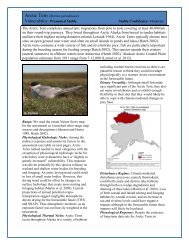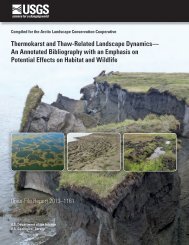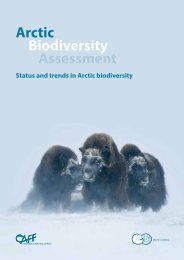Assessing Climate Change Vulnerability of Breeding Birds in Arctic ...
Assessing Climate Change Vulnerability of Breeding Birds in Arctic ...
Assessing Climate Change Vulnerability of Breeding Birds in Arctic ...
You also want an ePaper? Increase the reach of your titles
YUMPU automatically turns print PDFs into web optimized ePapers that Google loves.
Snow Goose (Chen Caerulescens)<strong>Vulnerability</strong>: Presumed StableConfidence: ModerateThe Snow Goose is a common breeder <strong>in</strong> <strong>Arctic</strong> Alaska, typically nest<strong>in</strong>g <strong>in</strong> small, densecolonies scattered near the coast. This species nests on flat tundra, near ponds, shallow lakes,streams, and islands <strong>in</strong> river deltas (Mowbray et al. 2000). Dur<strong>in</strong>g the breed<strong>in</strong>g season, their dietis primarily vegetarian, eat<strong>in</strong>g both aquatic and drier tundra vegetation (Mowbray et al. 2000).For brood rear<strong>in</strong>g, one <strong>of</strong> the more important habitats is salt affected tundra on islands <strong>in</strong> riverdeltas (J. Shook, pers. comm.). Most North Slope breeders w<strong>in</strong>ter <strong>in</strong> western North Americafrom British Columbia <strong>in</strong>to California (Mowbray et al. 2000). Current <strong>Arctic</strong> Coastal Pla<strong>in</strong>population is estimated at approximately 9,000 with an <strong>in</strong>creas<strong>in</strong>g trend (Larned et al. 2012).J. Liebezeit @ WCSRange: We used the extant NatureServe rangemap for the assessment as it closely matched the<strong>Birds</strong> <strong>of</strong> North America and other rangedescriptions (Bart et al. 2012, Johnson andHerter 1989).Sea Level Rise & Natural Barriers: Because <strong>of</strong>this its restricted range along coastal areas <strong>in</strong><strong>Arctic</strong> Alaska, this species was consideredslightly vulnerable to both sea-level rise and tolimitations <strong>in</strong> expansion <strong>of</strong> their range northward(“natural barriers” factor).Physiological Hydro Niche: Snow Geese werescored as particularly vulnerable to changes <strong>in</strong>hydrologic niche because <strong>of</strong> their significantassociation with coastal habitats (<strong>in</strong> particularsalt marsh), ponds, and wet tundra habitats fornest<strong>in</strong>g, forag<strong>in</strong>g, brood-rear<strong>in</strong>g, molt<strong>in</strong>g, andavoid<strong>in</strong>g predation. If substantial tundra dry<strong>in</strong>goccurs, this species could experience aconsiderable negative impact. Currentprojections <strong>of</strong> annual potential evapotranspirationsuggest negligible atmosphericdrivendry<strong>in</strong>g for the foreseeable future (TWSand SNAP). Thus atmospheric moisture, as anexposure factor (most <strong>in</strong>fluential on the“hydrological niche” sensitivity category), wasnot heavily weighted <strong>in</strong> the assessment.Disturbance Regime: <strong>Climate</strong>-mediateddisturbances, most importantly <strong>in</strong>creas<strong>in</strong>g storms(Jones et al. 2009) on the coastal pla<strong>in</strong>(<strong>in</strong>clud<strong>in</strong>g high w<strong>in</strong>ds) can back up water andcause the flood<strong>in</strong>g <strong>of</strong> river deltas. This maydestroy nests that are <strong>of</strong>ten less than a meterabove sea level. <strong>Breed<strong>in</strong>g</strong> densities could decl<strong>in</strong>enearest the coast, but they may be able tosuccessfully nest <strong>in</strong>land or redistribute to othercolony areas on the coastal pla<strong>in</strong> (J. Shook, pers.comm.).Interactions with Other Species: In terms <strong>of</strong><strong>in</strong>teractions with other species, it is possible thatred fox nest predation could <strong>in</strong>crease as thispredator’s range expands northward from borealregions (Pamper<strong>in</strong> et al. 2006). Geese wouldunlikely be able to defend nests as successfullyas aga<strong>in</strong>st the smaller arctic foxes. Also, climatechanges may disrupt the regularity <strong>of</strong> the44








